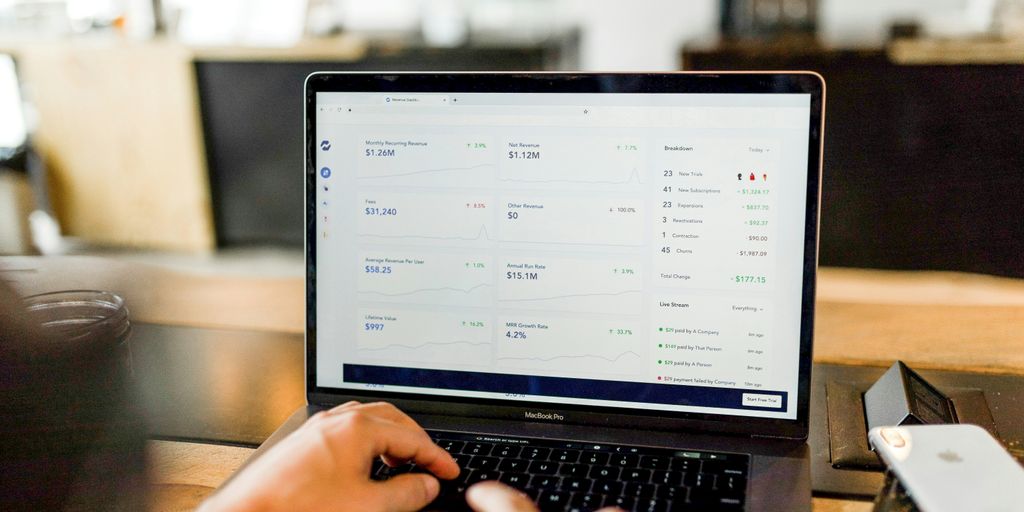Stock Market
A Step-by-Step Guide on How to Buy Stocks Online Without a Broker

Buying stocks online without a broker is more straightforward than you might think. With just a bit of know-how, you can own a piece of your favorite companies without paying a hefty commission. In this guide, we’ll walk you through the steps to purchase stocks directly, using methods like direct stock purchase plans and dividend reinvestment plans. Whether you’re a seasoned investor or just starting out, this guide will help you understand how to buy stocks online without a broker.
Key Takeaways
- You can buy stocks directly through companies using direct stock purchase plans (DSPPs).
- Dividend reinvestment plans (DRIPs) allow you to reinvest your earnings to buy more shares automatically.
- Opening an online brokerage account is quick and often has low fees.
- Researching stocks is crucial; use various tools to analyze potential investments.
- Managing your portfolio is important; know when to buy or sell based on your financial goals.
Understanding Online Stock Purchases
The Basics of Stock Ownership
So, you want to own a piece of a company? That’s what buying stock is all about! When you buy a share of stock, you’re essentially buying a tiny percentage of that company. It’s like owning a little slice of the pie. This means you get a say in some company decisions (though usually a very small say, depending on how many shares you own) and you’re entitled to a portion of the company’s profits, if they decide to distribute them as dividends. Think of it as becoming a part-owner, sharing in both the ups and downs of the business. It’s a pretty cool concept when you really think about it.
Benefits of Buying Stocks Online
Why buy stocks online? Well, for starters, it’s super convenient. You can do it from your couch in your pajamas! Online platforms have made investing way more accessible than it used to be. Plus:
- Lower fees: Online brokers typically charge way less in commissions than traditional brokers. This means more of your money goes toward actually buying stocks, and less toward paying someone else.
- More control: You’re in the driver’s seat. You get to decide which stocks to buy, when to buy them, and when to sell them. No one is pushing you to make decisions you’re not comfortable with.
- Access to information: The internet is a treasure trove of information about stocks and companies. You can research companies, read analyst reports, and track market trends all from your computer or phone. This helps you make informed decisions. You can find a brokerage account that fits your needs.
Common Misconceptions About DIY Investing
Okay, let’s clear up some myths about buying stocks on your own. First off, it’s not just for rich people. You can start with a relatively small amount of money. Second, you don’t need to be a financial genius to do it. Sure, there’s a learning curve, but there are tons of resources available to help you get started. However, don’t think it’s a get-rich-quick scheme. Investing in stocks involves risk, and you could lose money. It’s important to do your homework, understand the risks, and invest for the long term. It’s not gambling; it’s about carefully allocating capital to businesses you believe in. Direct Stock Purchase Plans are a great way to buy stocks without a broker.
Exploring Direct Stock Purchase Plans
So, you’re thinking about cutting out the middleman and buying stock directly from companies? Direct Stock Purchase Plans (DSPPs) might be just what you’re looking for. It’s a way to own stock without going through a traditional broker. Let’s get into the details.
What Are Direct Stock Purchase Plans?
Direct Stock Purchase Plans (DSPPs) let you buy shares directly from the company. Instead of using a broker, you’re dealing directly with the company (or their transfer agent). This often means lower fees and the ability to invest smaller amounts. It’s like buying straight from the source! Many companies, especially larger, publicly traded ones, offer DSPPs. Each company decides the minimum investment needed for both the first purchase and any later ones. It’s worth checking out if the companies you’re interested in offer this option.
How to Enroll in a DSPP
Enrolling in a DSPP usually involves a few steps. First, you’ll need to find out if the company you’re interested in offers a DSPP. You can usually find this information on the company’s website in the investor relations section. Once you’ve confirmed they have a plan, you’ll typically need to complete an application. This might involve providing personal information, like your social security number, and choosing how you want to fund your purchases. Many plans let you make recurring investments, which is pretty convenient. You might need to make an initial investment, often around $250 to $500. After that, you can usually set up regular contributions. It’s a pretty straightforward process, but make sure you read all the fine print before signing up. You can find more information about equity plan alternatives online.
Advantages and Disadvantages of DSPPs
Like anything, DSPPs have their pros and cons. On the plus side, you often get lower fees since you’re skipping the broker. Some companies even offer a small discount on the stock price, maybe 1% to 10%. Plus, many DSPPs allow for passive investing, where you invest a fixed amount regularly. However, there are downsides. DSPPs might require a higher initial investment, and you might not be able to buy fractional shares. Also, you’ll have multiple accounts to manage if you invest in several companies this way. And, DSPPs are generally better for long-term investments because they don’t offer the same flexibility as an online broker. Here’s a quick rundown:
Advantages:
- Lower fees
- Potential stock discount
- Recurring investments
Disadvantages:
- Higher initial costs
- Multiple accounts to manage
- Less flexibility than a brokerage account
Utilizing Dividend Reinvestment Plans

Overview of Dividend Reinvestment Plans
So, you’re thinking about reinvesting your dividends? Smart move! A Dividend Reinvestment Plan, or DRIP, is a cool way to use the dividends you earn from owning stock to buy even more stock in the same company. Instead of getting a cash payment, your dividends are automatically used to purchase additional shares, even fractional ones. It’s like a snowball effect for your investments. Dividend stocks can be a great choice for investors looking for passive income.
How to Set Up a DRIP
Setting up a DRIP is usually pretty straightforward. First, you need to own stock in a company that offers a DRIP. Not all companies do, so that’s the first thing to check. Once you’ve confirmed that, here’s what usually happens:
- Check with the Company or Transfer Agent: Many companies handle DRIP enrollment directly through their investor relations department or a transfer agent. You can find this info on the company’s website.
- Enroll in the Plan: You’ll likely need to fill out an enrollment form, either online or by mail. This form will ask for your shareholder information and instructions on how you want your dividends reinvested.
- Confirm Enrollment: Once your enrollment is processed, your dividends will automatically be reinvested to purchase more shares. You’ll usually receive statements detailing the purchases.
Benefits of Reinvesting Dividends
Reinvesting dividends has some pretty sweet advantages:
- Compounding Returns: This is the big one. By reinvesting your dividends, you’re buying more shares, which in turn generate more dividends. It’s a cycle that can really boost your long-term returns. It’s automated, compounded growth!
- Dollar-Cost Averaging: DRIPs often allow you to buy fractional shares, meaning you can invest the exact amount of your dividend each time, regardless of the share price. This can help you take advantage of dollar-cost averaging, where you buy more shares when prices are low and fewer when prices are high.
- Low or No Fees: Many DRIPs are offered with little to no transaction fees, which can save you money compared to buying shares through a traditional broker. You can purchase shares directly from the company for a low fee or no fee at all.
Of course, dividends are still taxable, even if you reinvest them. So, keep that in mind when you’re doing your taxes. Also, the selection of companies offering DRIPs might be smaller than what you’d find with a regular brokerage account. But overall, DRIPs are a solid option for long-term investors looking to grow their wealth.
Setting Up an Online Brokerage Account
Choosing the Right Online Brokerage
Finding a broker can feel like shopping online for shoes. You want low fees, tools that make sense, and a solid reputation. Look for:
- Zero or low trade fees
- An easy-to-use mobile app
- Positive customer ratings
- Basic learning materials for new investors
Sometimes big news like the recent tariff cuts can drive wild swings. Make sure your broker can handle extra traffic when markets move fast.
Steps to Open an Account
- Go to the broker’s site and click “Sign Up.”
- Fill in your name, address, Social Security number, and contact info.
- Verify your identity—often by uploading a photo of your driver’s license.
- Link your checking or savings account for deposits.
- Set up security features, such as two-factor authentication.
Understanding Account Types and Fees
Different accounts work better for different goals. Here’s a quick look at the main options:
| Account Type | Tax Treatment | Typical Fees |
|---|---|---|
| Standard (Taxable) | Pay taxes yearly | $0–$5 per trade, no monthly charge |
| Traditional IRA | Tax-deferred | Trade fees apply, 10% early penalty |
| Roth IRA | Tax-free growth | Trade fees apply, income limits |
Review the fine print on fees before you sign up.
Besides trade costs, watch out for:
- Inactivity fees if you go long without trading
- Margin interest if you borrow money
- Withdrawal or wire fees when you move cash out
Researching Stocks to Buy
How to Analyze Stock Performance
Okay, so you’re ready to pick some stocks. Awesome! But before you just throw money at any random company, you gotta do your homework. Analyzing stock performance isn’t as scary as it sounds. Basically, you’re trying to figure out if a company is doing well and if its stock is likely to go up (or at least not tank).
- Start with the basics: Look at the company’s revenue, earnings, and debt. Are they making money? Are they growing? Are they drowning in debt? These are important questions. You can usually find this info in their financial statements.
- Check out key ratios: Things like the price-to-earnings ratio (P/E), price-to-sales ratio (P/S), and debt-to-equity ratio (D/E) can give you a quick snapshot of a company’s valuation and financial health. Compare these ratios to other companies in the same industry to see how they stack up. For example, a high P/E ratio might mean the stock is overvalued.
- Read the news: What are people saying about the company? Are there any major news events that could affect the stock price? Keep an eye on industry trends and competitor activity. All of this can give you a better sense of the company’s prospects. The Dow Jones Industrial Average can give you a sense of the overall market.
Tools for Stock Research
Luckily, you don’t have to do all this research by hand. There are tons of tools out there to help you analyze stocks. Some are free, and some require a subscription, but they can all save you a lot of time and effort.
- Financial websites: Sites like Yahoo Finance, Google Finance, and MarketWatch offer free stock quotes, charts, news, and financial data. They’re a great place to start your research.
- Brokerage platforms: Many online brokers offer research tools and analysis as part of their services. These tools can help you screen stocks, analyze financial statements, and track your portfolio. Check out the best brokers for beginners to find one that fits your needs.
- Subscription services: If you’re serious about stock investing, you might consider subscribing to a research service like Morningstar or The Motley Fool. These services offer in-depth analysis, stock recommendations, and other resources to help you make informed investment decisions.
Understanding Market Trends
It’s not enough to just analyze individual companies. You also need to understand what’s going on in the overall market. Market trends can have a big impact on stock prices, so it’s important to stay informed.
- Keep an eye on economic indicators: Things like GDP growth, inflation, and interest rates can all affect the stock market. Pay attention to what the Federal Reserve is doing and how it might impact the economy.
- Follow industry trends: Are there any major trends that are affecting certain industries? For example, the rise of electric vehicles is impacting the auto industry, and the growth of e-commerce is impacting the retail industry. Understanding these trends can help you identify promising investment opportunities.
- Don’t try to time the market: Trying to predict short-term market movements is a fool’s errand. Instead, focus on long-term trends and invest in companies that you believe will do well over time. Remember, you want to invest for the long term, not make a quick buck.
Making Your First Stock Purchase
Deciding How Much to Invest
Okay, so you’ve done your research, picked a stock, and now it’s time to actually buy it. The big question is: how much should you invest? It’s easy to get caught up in the excitement, but it’s super important to be smart about this. Don’t feel pressured to buy a ton of shares right away. You can always add more later.
Here’s a few things to consider:
- Start Small: Seriously, you can buy just one share if you want! It’s a great way to get a feel for things without risking a lot of money. Think of it as dipping your toes in the water before jumping into the deep end. Some people even start with paper trading to get the hang of it.
- Only Invest What You Can Afford to Lose: This is investing 101, but it’s worth repeating. The stock market can be unpredictable. Don’t use money you need for rent, bills, or groceries. If the stock goes down, you don’t want to be in a tough spot.
- Think Long-Term: Investing is usually a marathon, not a sprint. If you’re investing for the long haul, temporary dips in the market shouldn’t freak you out too much.
Placing Your Order Online
Alright, you’ve decided how much to invest. Now, let’s actually buy some stock! Here’s how it usually works:
- Log in to your brokerage account: Head to your online brokerage account.
- Find the stock: Use the search bar to find the stock you want to buy. You’ll usually type in the company’s ticker symbol (like AAPL for Apple).
- Choose your order type: You’ll usually see a few different order types. The two most common are:
- Market Order: This tells your broker to buy the stock at the current market price. It’s the simplest option, but the price can fluctuate a bit while the order is being processed.
- Limit Order: This lets you set a specific price you’re willing to pay. Your order will only go through if the stock price hits that level. It gives you more control, but there’s a chance your order won’t be filled if the price never drops to your limit.
- Enter the number of shares: Type in how many shares you want to buy.
- Review and submit: Double-check everything to make sure it’s correct, and then hit that
Managing Your Stock Portfolio

So, you’ve bought some stocks! Congrats! Now comes the part where you actually, you know, manage them. It’s not a ‘set it and forget it’ kind of deal, unless you really like surprises (and not the good kind).
Strategies for Portfolio Diversification
Okay, diversification. Sounds fancy, right? Basically, it means don’t put all your eggs in one basket. I mean, what if that basket falls? You’re gonna have a bad time. Diversifying your portfolio is about spreading your investments across different sectors, industries, and even geographic regions. This way, if one sector tanks, the rest of your portfolio can hopefully cushion the blow. Think of it like this: you wouldn’t eat only pizza for every meal, would you? (Okay, maybe some people would, but it’s not exactly healthy). Same goes for your investments. A good way to start is by looking at key tech stocks and other sectors.
Here’s a simple example:
| Asset Class | Percentage |
|---|---|
| Stocks | 60% |
| Bonds | 30% |
| Real Estate | 10% |
When to Buy or Sell Stocks
This is the million-dollar question, isn’t it? There’s no magic formula, and anyone who tells you otherwise is probably trying to sell you something. But here are a few things to consider:
- Company Performance: Is the company doing well? Are their earnings up? Are they innovating? If a company is consistently underperforming, it might be time to cut your losses.
- Market Conditions: Is the overall market bullish or bearish? Are there any major economic events on the horizon that could impact your stocks?
- Your Investment Goals: Have your goals changed? Do you need the money for something else? Sometimes, selling a stock isn’t about the stock itself, but about your personal circumstances.
Tracking Your Investment Performance
You absolutely need to keep an eye on how your investments are doing. Most brokerage accounts have tools to help you track your performance over time. Pay attention to things like:
- Total Return: This is the overall profit or loss on your investments, including dividends and capital gains.
- Benchmark Comparison: How is your portfolio performing compared to a relevant benchmark, like the S&P 500? If you’re consistently underperforming the benchmark, it might be time to re-evaluate your strategy.
- Fees and Expenses: Are you paying too much in fees? Even small fees can eat into your returns over time. Consider switching to a lower-cost brokerage if necessary.
It’s a marathon, not a sprint. Don’t get discouraged by short-term fluctuations. Stay informed, stay disciplined, and you’ll be well on your way to building a successful stock portfolio.
Wrapping It Up
So there you have it! Buying stocks online without a broker is totally doable. You can go for direct stock purchase plans or use online brokerage accounts, and both options have their perks. Just remember to do your homework before jumping in. Look into the companies you’re interested in and understand how much you want to invest. It might feel a bit overwhelming at first, but with a little patience and practice, you’ll get the hang of it. Happy investing!
Frequently Asked Questions
Can I buy stocks without a broker?
Yes, you can buy stocks without using a broker. You can do this through online accounts or special plans that let you buy directly from companies.
What is a Direct Stock Purchase Plan (DSPP)?
A Direct Stock Purchase Plan allows you to buy shares directly from a company, usually without a broker.
How do I set up a Dividend Reinvestment Plan (DRIP)?
To set up a DRIP, you need to enroll in the plan offered by the company whose stock you own. This plan automatically uses your dividends to buy more shares.
What should I consider when choosing an online brokerage?
When picking an online brokerage, look for low fees, good customer service, and easy-to-use tools for trading.
How do I start researching stocks?
You can research stocks by looking at financial news, using stock analysis websites, or following market trends to see how companies are performing.
What are some tips for managing my stock investments?
To manage your stock investments, diversify your portfolio, keep track of your stock performance, and know when to buy or sell based on market conditions.
-

 Home and Garden3 days ago
Home and Garden3 days agoTransform Your Space: A Guide to Minimalist House Interior Design in 2025
-

 Home & Family4 days ago
Home & Family4 days ago10 Essential Cleaning Hacks for Bathroom Surfaces You Need to Try
-

 Innovations6 days ago
Innovations6 days agoWill AI Take Your Job? The Truth About Automation and Employment
-

 Crime4 days ago
Crime4 days agoExploring the Most Anticipated New True Crime Documentaries of 2025
-

 Health & Fitness3 days ago
Health & Fitness3 days agoDiscover the Best Multivitamin for Women Over 40: A Comprehensive Guide to Optimal Health
-

 Health & Fitness4 days ago
Health & Fitness4 days agoDiscovering the Best Multivitamin for Women Over 40: Essential Nutrients for Optimal Health
-

 Business4 days ago
Business4 days agoMaximize Your Earnings with American Express High Yield Savings Accounts in 2025
-

 Education3 days ago
Education3 days agoDiscover the Best App for Language Learning in 2025: Your Ultimate Guide


















